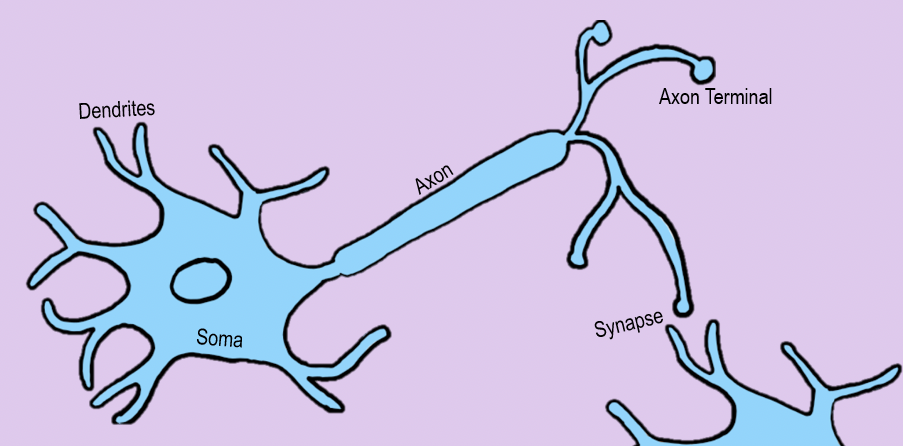Have you ever played with building blocks? Maybe you’ve built a really tall tower, a cool building, or even an airplane from blocks or Legos. Your body is also made of building blocks. However, these building blocks look very different from the ones you are used to. They are called cells, and they make up your body.
There are many types of cells. They come in different shapes and sizes. For example, there are skin cells, muscle cells, blood cells, fat cells, and many more. There are even special brain cells, and these are called neurons.
You might have read the blog post about the nervous system. This blog talks briefly about the importance of neurons, but this post will look deeper into the function of neurons.
First, let’s talk about what a neuron looks like. As you can tell from the picture, neurons are not shaped like normal building blocks. The large, sort of circular part of the neuron is the soma. Soma is another word for the cell body. This is where a lot of important cell structures are housed. The branches that extend from the soma are called dendrites. They play an important role of receiving signals from other neurons and molecules. Their branches reach out and can gather information from their neighboring neurons. Messages from a neuron are sent down the long “tail” of the neuron. This is called the axon. It’s like a highway for the signal, as messages are quickly sent down the axon. Some axons have a special coating, called a myelin sheath, which helps messages travel even faster down them. At the end of the axon are the axon terminals. This is where messages are sent to the next neuron.
What are these messages? Neurotransmitters are chemicals that communicate a message from one neuron to another. They are packaged into vesicles at the axon terminal and sent to the next neuron. Where is the message received? The dendrites.
However, the dendrites of one neuron don’t actually touch the axon terminal of another neuron. They are separated by a very small space, called a synapse. Neurotransmitters, packaged in vesicles, must travel across this synapse to bring their message to the next neuron. It’s kind of like playing catch. Imagine throwing a ball to your friend. The ball is the neurotransmitter, and you, as the axon terminal, have to throw the ball across the synapse. It will then be received by your friend, the dendrites.
Once neurotransmitters are received by the dendrites of a neuron, they can affect change in that neuron. This may result in that neuron sending a signal down it’s axon to send a message to the next neuron.
According to the University of Queensland, there are about 100 billion neurons. That’s a lot of building blocks, and there are even more cells in the rest of your body! These 100 billion neurons play an important role of receiving sensory information, relaying messages, and sending commands to other parts of the body. Remember, neurons help make up the nervous system.
Neurons are just one of the many types of cells that make up the body. You are made up of many different types of building blocks!
Author: Grace Brolly
